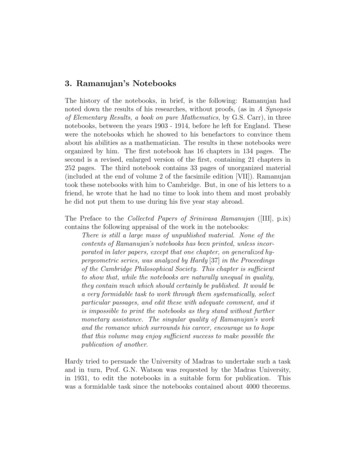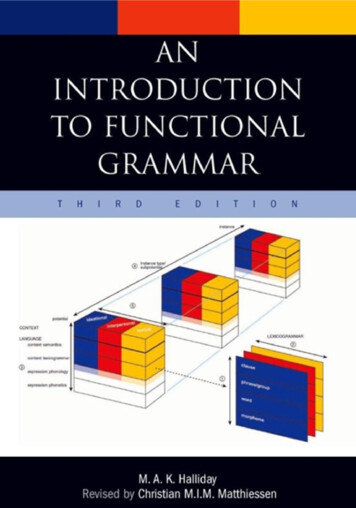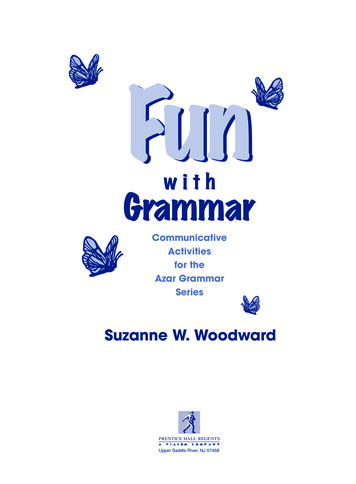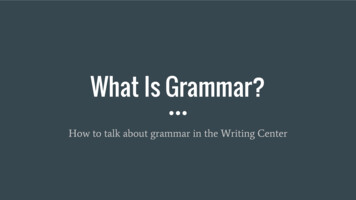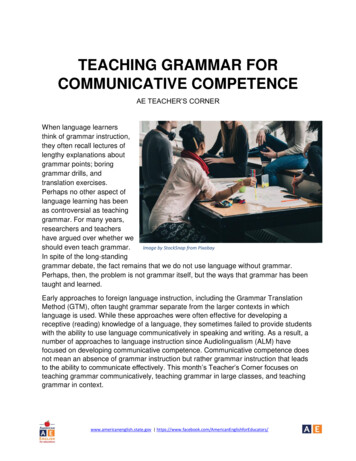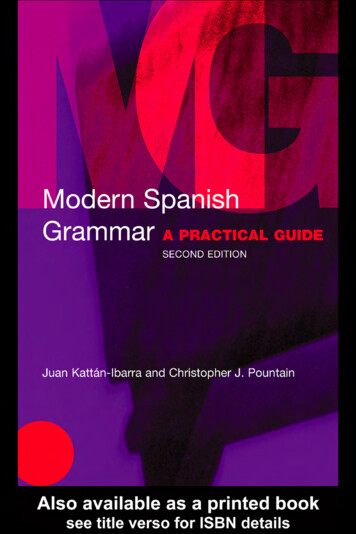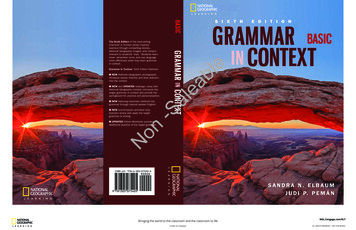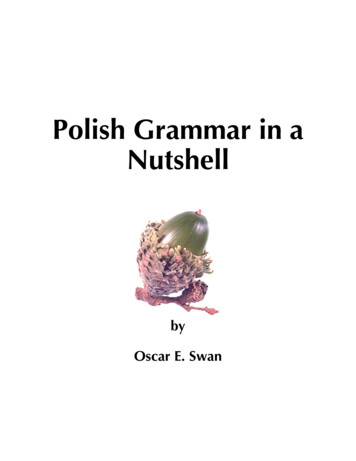
Transcription
Interactive Grammar NotebooksLesson 0.5: Parts of Speech2.3.4.5.Just so you know, I’m in no way affiliated with RRR Educational Rap Company. I’mjust a huge fan and long-time customer! I’ve blogged about them before, and theirFigurative Language Rap is unbelievably awesome.Back to this template – start by coloring (you know I’m a color-coder!) and cuttingout the pieces as shown below. It’s important to cut out the little notches betweeneach tab so that it functions right when it’s put together. Look closely at the photobelow to make sure you cut it out on the proper lines.Now comes the tricky part. Fold each tab over so thatjust the colored part shows. It should look like thephotos on either side below.In the center photo, notice how to put the glue dots onthe back side sections only when gluing into thenotebook.12 2014 erin cobbimlovinlit.com
Interactive Grammar NotebooksLesson 1-1Hard & Fast Rules forRule*Capitalization*Examples1. Do capitalize the first letter ofa proper noun, a name for aperson, place, thing, or event.George Washington; Canada;Dr. Pepper; the Rocky Mountains;the Lincoln Tunnel; World War II2. Do capitalize all significantwords in titles of books,magazines, stories, movies, andother media. Always capitalizethe first and last words.Do NOT capitalize articles (a, an,the), prepositions (as, at, of on,for, in), or conjunctions (and,but, or) that contain fourletters or fewer.A Tale of Two CitiesThe Scarlett LetterThe New York T imesRevenge of the Teenage Vixens fromOuter SpaceThe Star-Spangled BannerThe Complete Idiot’s Guide to SewingOf Mice and Men3. Do capitalize the first letter ofa sentence, even in a quotation.My mother said, “Your father will behome shortly.”4. Do capitalize names ofrelatives that indicate familyrelationship when used with theperson’s name or alone as thename you call that person.Aunt Karen gives great presents.Please ask Grandmother to answerher telephone.Dad gets home early on Fridays, butMom usually works late.5. Do capitalize a title thatprecedes a name, but do notcapitalize a title that follows aname or is used as a generalword.I wrote a letter to Governor Jindal.I also wrote to Bobby Brown, a senatorfrom Louisiana.Do capitalize titles whenaddressing someone directly.Thank you for your response,Governor.Do I need to come in today, Doctor?6. Do capitalize countries,nationalities, and languages.England, English, AmericanSpain, Spanish17 2014 erin cobbINB Page #imlovinlit.com
Interactive Grammar NotebooksLesson 1-1Hard & Fast Rules Practice *Capitalization*Each sentence below contains mistakes. Use your “Hard & Fast Rules” sheet to identify the mistakesand correct them in the space below. Then, identify which rule(s) apply to the sentence.1. On the way to visit my Aunt in california, we crossed thegolden gate bridge.On the way to visit my aunt in California, we crossed the GoldenGate Bridge. Rules 1,42. From the backseat I heard dad shout, “wake up, kids, andtake in this view!”From the backseat I heard Dad shout, “Wake up, kids, and take inthis view!” Rules 3, 43. Grandma florence, whose other son is a Senator, startedtalking way too fast in french.Grandma Florence, whose other son is a senator, started talkingway too fast in French. Rules 4, 5, 64. Then, I realized that this was the same bridge from the ThemeSong to the television show full house.Then, I realized that this was the same bridge from the themesong to the television show Full House. Rule 25. My brother never looked up from the book he was reading,the Hunger Games.My brother never looked up from the book he was reading, TheHunger Games. Rule 26. my mother said, “what a beautiful sight!” and then shehugged dad.My mother said, “What a beautiful sight!” and then she hugged Dad.Rules 3-421 2014 erin cobbimlovinlit.com
Interactive Grammar NotebooksLesson 4-2: Predicate Nominatives & Predicate Adjectives120 2014 erin cobbimlovinlit.com
Interactive Grammar NotebooksLesson 4-2: Predicate Nominatives & Predicate AdjectivesPurpose: Identify and distinguish between predicate nominatives and predicateadjectives. Describe the function of each.Technology/Resources:n/aProcedures:1. I like to start this lesson by telling my students that predicate nominatives andpredicate adjectives sound very complicated, but they are SO simple! Be sure toconnect this lesson with the previous lesson, specifically linking verbs.2. Go ahead and cut out the two pieces. For the predicate nominative, write thesentence “Sam is a doctor.” inside the links as shown below. Then, in the predicateadjective piece, write “I was tired.”3. Glue down the tabs for each piece. Then, snip the vertical lines between the links.4. Write the definitions for predicate nominatives and predicate adjectives above eachtab-template, as shown below.5. Read the sorting sentences. Decide whichsentences have predicate nominatives andwhich have predicate adjectives. Then, divideup the sentences and write them under thecorrect tabs. The photo to the right showswhat it looks like under the predicatenominative tabs.6. Notes for writing in the templates and on thepage are on the following page.121 2014 erin cobbimlovinlit.com
Interactive Grammar NotebooksLesson 4-2: Predicate Nominatives & Predicate AdjectivesNotes for Writing Inside Templates and on Page:definitions (write on page above each tab)predicate nominative – a noun or pronoun that follows the linking verb and identifies orexplains the subjectpredicate adjective – an adjective that follows the linking verb and describes the subjectSorting Sentences1.My headache // became // worse. (adjective)2. Charlie // seems // upset about his grades. (adjective)3. Baton Rouge // is // the capital of Louisiana. (nominative)4. The platypus // is // a mammal. (nominative)5. This job // seems // difficult. (adjective)6. John // is // the president of Student Council.*Notice that I did not include the prepositional phrases under the tabs, as they areextra information and there isn’t room for them in the template – only the basicsubject-predicate structures that are being emphasized here.122 2014 erin cobbimlovinlit.com
Interactive Grammar NotebooksLesson 4-2: Predicate Nominatives & Predicate AdjectivesPredicate NominativeSubject Linking VerbNounPredicate AdjectiveSubject Linking Verb AdjectiveSorting Sentences1.My headache became worse.2. Charlie seems upset about his grades.3. Baton Rouge is the capital of Louisiana.4. The platypus is a mammal.5. This job seems difficult.6. John is the president of Student Council.123 2014 erin cobbimlovinlit.com
Interactive Grammar NotebooksTable of ContentsUnit 2: SentencesUnit 1: Hard & Fast Rules for Grammar*LICENSE INFORMATION*This product is intended for use in a single classroom only. Copying for other teachers and sharingwithout purchasing additional licenses is not permitted.Table of Contents2-5Teacher’s Guide: Getting Started FAQ6-9Lesson 0.5: Parts of Speech Overview Completed Notebook Page10Lesson 0.5: Parts of Speech Overview Teacher’s Instructions & Notes11-13Lesson 0.5: Parts of Speech Overview Student Pages14-15Unit 1: Introduction & Teacher’s Instructions for Hard & Fast Rules Sheets16Lesson 1.-1: Hard & Fast Rules for Capitalization17-19Lesson 1-1 Student Practice and Answer Keys20-21Lesson 1-2: Hard & Fast Rules for Using Commas22-24Lesson 1-2: Student Practice and Answer Keys25-26Lesson 1-3: Hard & Fast Rules for Using Apostrophes27-29Lesson 1-3: Student Practice and Answer Keys30-31Lesson 1-4: Hard & Fast Rules for Using Quotation Marks32-34Lesson 1-4: Student Practice and Answer Keys35-36Lesson 1-5: Hard & Fast Rules for Using Numbers37-39Lesson 1-5: Student Practice and Answer Keys40-41Lesson 1-6: Hard & Fast Rules for Plurals42-44Lesson 1-6: Student Practice and Answer Keys45-46Lesson 1-7: Hard & Fast Rules for Using Commonly Confused Words47-49Lesson 1-7: Student Practice & Answer Keys50-51Lesson 2-1: Four Types of Sentences – Activities 1-2 Completed Notebook Pages52-53Lesson 2-1: Four Types of Sentences Teacher’s Instructions & Notes54-55Lesson 2-1: Four Types of Sentences Student Pages56-58Lesson 2-2: Subjects & Predicates – Activities 1-2 Completed Notebook Pages59-61Lesson 2-2: Subjects & Predicates Teacher’s Instructions & Notes62-65Lesson 2-2: Subjects & Predicates Student Pages66-702 2014 erin cobbimlovinlit.com
Unit 3: NounsUnit 2: SentencesInteractive Grammar NotebooksTable of ContentsLesson 2-3: Compound Subjects & Predicates Completed Notebook Page71Lesson 2-3: Compound Subjects & Predicates Teacher’s Instructions & Notes72-73Lesson 2-3: Compound Subjects & Predicates Student Pages74-75Lesson 2-4: Simple & Compound Sentences Completed Notebook Page76Lesson 2-4: Simple & Compound Sentences Teacher’s Instructions & Notes77Lesson 2-4: Simple & Compound Sentences Student Pages78-81Lesson 2-5: Independent & Dependent Clauses Act. 1-2 Completed Notebook Page82-83Lesson 2-5: Independent & Dependent Clauses Teacher’s Instructions & Notes84-85Lesson 2-5: Independent & Dependent Clauses Student Page, Activity 186Lesson 2-5: Independent & Dependent Clauses Notes Page, Activity 187Lesson 2-5: Independent & Dependent Clauses Student Pages, Activity 288-89Lesson 2-6: Sentences, Fragments, & Run-Ons Completed Notebook Page90Lesson 2-6: Sentences, Fragments, & Run-Ons Teacher’s Instructions & Notes91Lesson 2-6: Sentences, Fragments, & Run-Ons Student Page92Lesson 3-1: Common & Proper Nouns Completed Notebook Page93Lesson 3-1: Common & Proper Nouns Teacher’s Instructions & Notes94-95Lesson 3-1: Common & Proper Nouns Student Pages96-97Lesson 3-2: Concrete & Abstract Nouns Completed Notebook Page98Lesson 3-2: Concrete & Abstract Nouns Teacher’s Instructions & Notes99Lesson 3-2: Concrete & Abstract Nouns Student Pages100-102Lesson 3-3: Plural Nouns Completed Notebook Page103Lesson 3-3: Plural Nouns Teacher’s Instructions & Notes, Activities 1-2104-105Lesson 3-3: Plural Nouns Student Pages, Activities 1-2106-108Lesson 3-4: Possessive Nouns Completed Notebook Page109Lesson 3-4: Possessive Nouns Teacher’s Instructions & Notes110-111Lesson 3-4: Possessive Nouns Student Page1123 2014 erin cobbimlovinlit.com
Unit 5: PrepositionsUnit 4: VerbsInteractive Grammar NotebooksTable of ContentsLesson 4-1: Action, Linking, & Helping Verbs Completed Student Pages113-114Lesson 4-1: Action, Linking, & Helping Verbs Teacher’s Instructions & Notes115-116Lesson 4-1: Action, Linking, & Helping Verbs Student Pages117-119Lesson 4-2: Predicate Nominatives & Predicate Adjectives Completed Student Page120Lesson 4-2: Predicate Nominatives & Predicate Adjectives Teacher’s Instructions121-122Lesson 4-2: Predicate Nominatives & Predicate Adjectives Student Page123Lesson 4-3: The Perfect Tense Fence Completed Student Page124Lesson 4-3: The Perfect Tense Fence Teacher’s Instructions & Notes125Lesson 4-3: The Perfect Tense Fence Student Pages126-129Lesson 4-4: Infinitives & Participles (Principal Parts) Completed Student Pages130-131Lesson 4-4: Infinitives & Participles (Principal Parts) Teacher’s Instructions & Notes132-133Lesson 4-4: Infinitives & Participles (Principal Parts) Student Pages134-135Lesson 4-4: Infinitives & Participles (Principal Parts) BONUS: Irregular Verb Charts136-139Lesson 4-5: Direct & Indirect Objects Completed Student Page140Lesson 4-5: Direct & Indirect Objects Teacher’s Instructions & Notes141-142Lesson 4-5: Direct & Indirect Objects Student Page143Lesson 5-1: Prepositions Completed Student Pages144-145Lesson 5-1: Prepositions Teacher’s Instructions & Notes146-147Lesson 5-1: Prepositions Student Pages148-150Lesson 5-2: Prepositional Phrases Completed Student Page151Lesson 5-2: Prepositional Phrases Teacher’s Instructions & Notes152Lesson 5-2: Prepositional Phrases Student Page153Lesson 5-3: Adverb & Adjective Phrases Completed Student Page154Lesson 5-3: Adverb & Adjective Phrases Teacher’s Instructions & Notes155Lesson 5-3: Adverb & Adjective Phrases Student Page1564 2014 erin cobbimlovinlit.com
Unit 9: Conjunctions& InterjectionsUnit 8: AdverbsUnit 6:Unit 7: Adjectives PronounsInteractive Grammar NotebooksTable of ContentsLesson 6-1: Pronouns Completed Student Page157Lesson 6-2: Identifying Pronouns Completed Student Page158Lessons 6-1 & 6-2: Pronouns Teacher’s Instructions & Notes159-160Lessons 6-1 & 6-2: Pronouns Student Pages161-162Lesson 7-1: Kinds of Adjectives Completed Student Page163Lesson 7-1: Kinds of Adjectives Teacher’s Instructions & Notes164Lesson 7-1: Kinds of Adjectives Student Pages165Lesson 7-2: Degrees of Comparison Completed Student Page166Lesson 7-2: Degrees of Comparison Teacher’s Notes & Instructions167Lesson 7-2: Degrees of Comparison Student Pages168-169Lesson 8-1: Adverbs Completed Student Pages170-171Lesson 8-1: Adverbs Teacher’s Instructions & Notes172Lesson 8-1: Adverbs Student Pages173-176Lesson 8-2: More Adverb Phrases Completed Student Page177Lesson 8-2: More Adverb Phrases Teacher’s Instructions & Notes178Lesson 8-2: More Adverb Phrases Student Page179Lesson 8-3: Double Negatives Completed Student Page180Lesson 8-3: Double Negatives Teacher’s Instructions & Notes181Lesson 8-3: Double Negatives Student Page182Lessons 9-1 & 9-2: Coordinating and Correlative Conjunctions Completed Student P183Lessons 9-1 & 9-2: Coordinating and Correlative Conjunctions Teacher’s Notes184-185Lessons 9-1 & 9-2: Coordinating and Correlative Conjunctions Student Pages186-189Lesson 9.3: Interjections Completed Student Page190Lesson 9.3: Interjections Teacher’s Instructions & Notes191Lesson 9.3: Interjections Student Pages192-193Common Core Alignment for Grades 4-8194-195Credits1965 2014 erin cobbimlovinlit.com
Interactive Grammar NotebooksFAQ/Getting Started Guide for Interactive NotebooksWhy should I use interactive notebooks when I’m already struggling to fit everything into my day?Interactive notebooks should not be another thing added to your day on top of what you arealready doing. Instead, change what you are already doing to accommodate interactive notebooks.As a middle school teacher, I was already having my students take notes into their notebooksanytime I taught new content (such as what is included in this packet). Interactive notebookingtook the place of my giving notes. I consider the time it takes my students to construct theirinteractive notes as part of my explicit instruction time. And it is so much more meaningful thana lecture!When students construct these 3D graphic organizers and then put the information they arelearning into them, they are making connections and organizing these topics in their brains in adifferent and more meaningful way than they would be if I were simply lecturing this material orif they were simply taking notes. Furthermore, most of my interactive notes are organized in away that students can study them like flashcards without having to go through the trouble ofwriting out flashcards.Do I have to use composition notebooks?Although teachers have successfully used spiral notebooks for interactive notebooking, compositionbooks are truly better. They are more durable, less likely to fall apart, and the pages are far lesslikely to get torn out.I first decided to use interactive notebooks after a summer workshop when school supplies hadalready been ordered. Since I have about 150 students, my school (mandates that studentspurchase pre-packaged supplies) had already purchased 150 Five Star spiral 3-subject notebooksfor me. No way was I getting composition notebooks on top of that! So I waited for them to go onsale at Wal-Mart and Target for 0.50 each and slowly purchased 150 of them, about 40 at atime. Some were also purchased (in limited quantities) at Big Lots and Walgreens for as low as 0.20.Now, you can still implement interactive 3d graphic organizers without ever putting them into anotebook if this works better for you. One teacher I met makes lapbooks for each of her socialstudies units. After she grades them and shows students their grades, she collects the unitlapbooks and files them. Then, she hands them all back before state testing so that students canstudy. If you’re interested in compiling these into lapbooks, here’s a great tutorial on v t1inXbba3cg6 2014 erin cobbimlovinlit.com
Interactive Grammar NotebooksFAQ/Getting Started Guide for Interactive NotebooksDoes the type of glue really matter?Absolutely! You definitely need to use Elmer’s school glue when gluing items into your interactivenotebooks. Many students may purchase and use the glue sticks, but these are definitely notrecommended for interactive notebooking. Yes, they’re more convenient and less messy, but theywill not bond the paper permanently. I always tell my students that we use liquid glue because it willstick “forever.”Not only does the type of glue matter, but the method of gluing matters also. Here’s a tip Ilearned at a workshop: NO TOASTER STRUDELING! You know what I’m talking about, and yourkids will LOVE this analogy. I even begin by putting an image of a yummy cream cheese toasterstrudel up on my SmartBoard and asking my students if they’ve ever eaten one. Most of themhave. Do you like putting on the icing? Most students will say it’s their favorite part! Well, you willNOT be toaster strudeling in my classroom! This analogy really works for reminding students ofthe correct method of gluing items into interactive notebooks. Toaster strudeling will result inwavy pages and huge, sticky messes. So what’s the proper way to glue? Use small dots (I call thembaby dots) spread about 1 inch apart. That’s it! The phrases I use with my students are “just adot, not a lot” and “baby dots” and of course “NO toaster strudeling!”How should I organize my interactive notebooks?Before interactive notebooks, my students’ literature notebooks were a nightmare! Now, insteadof students having a hodge-podge spiral notebook that contains many random things (and noteshere and there), they have an organized reference book of everything I’ve taught them thatmakes it easy to study now and easy to save for future reference. During finals last year, I askedone 8th grade girl, “Where is your literature notebook? I told you to make sure it was in classtoday!” She responded “I left it at home. My brother is in 10th grade and he was borrowing it tostudy for his English final.” Needless to say, the girl did not receive the usual 1 point off for nothaving her materials. It is my hope that the interactive notebooks my students take away frommy class can serve as a valuable reference source for them in the high school years ahead (andbeyond!).When you begin using your interactive notebooks, be sure to leave about 3 blank pages at thebeginning for your table of contents. Every time you make another entry, log it in your table ofcontents. What a great real-world lesson on this text feature! Here is an example of what onepage of the table of contents looked like for my 7th grade notebook.7 2014 erin cobbimlovinlit.com
Interactive Grammar NotebooksFAQ/Getting Started Guide for Interactive NotebooksIn what order should I teach the conceptsin the Interactive Poetry Notebookspacket?I have included many lessons and skills that Iteach to my 6th, 7th, and 8th gradeliterature students. The order I presentedthem in this packet is close to the order inwhich I teach these skills. Still, they can betaught in any order or sequence that fitsyour classroom and the skills that youteach! You can skip some skills, dig intoothers more deeply, and mix and matchthem as you see fit. Take what works foryou and modify it to fit your own classroomneeds.Furthermore, if you look closely at thetable of contents, you will see that noteverything in my students’ interactivenotebook is content. I also have studentsglue in their AR goals, records, and eveninstructions that I don’t want them to lose,such as how to access my Quizlet site.You recommend many Youtube video clips, but my school blocks Youtube on our network.There are a couple of ways around that. First, you can create SafeShare.tv links from home byvisiting http://safeshare.tv and entering in the Youtube video link I have provided. This willproduce an ad-free (and comment-free!) video page that many schools allow on their network.The second option and the option I use is http://www.savetube.com. You might be required toupdate your java, but after that you will be able to enter a Youtube video link and then downloada .mp4 file (Mac) or a .wmv file (Windows) that you can bring to school on a flash drive, networkdrive, or stash in your Google drive. I like using this method because I can keep the video clipssaved for next year, but it does require a level of technical proficiency and some users strugglewith it.*IMPORTANT* Links in a PDF do not always work correctly. If you receive an error whenclicking a link, try copying and pasting the link instead of clicking it.8 2014 erin cobbimlovinlit.com
Interactive Grammar NotebooksFAQ/Getting Started Guide for Interactive NotebooksDo I need separate composition notebooks for poetry, reading literature, reading informationaltext, grammar, and/or writing?NO! My students keep all of their ELA interactive activities in ONE notebook. I can imagine thatusing multiple notebooks would create a nightmare of having the right notebook at the right timeand gluing the wrong template into the wrong notebook. I have come a little close, but I havenever filled an entire composition notebook. If we happened to fill one, I guess we’d just get newnotebooks and start over, keeping the old ones around for reference! As long as we‘re loggingwhat we’re doing in the Table of Contents, it will be easy enough to find what we need, even if itIS all in one notebook.What about Bell Ringers and/or daily writing entries? Do you put those into the interactivenotebook?NO WAY! I never have my students “stick” random things into their precious interactivenotebooks. These notebooks are sacred and no kind of daily work or jargon goes in there.Everything we put into our notebooks is useful in some way. I put things into the notebook thatwe will need to refer back to at some point, to help recall information, and as a record of theconcepts, skills, and strategies we’ve learned. Don’t junk up that notebook! I have another placefor daily activities and free-write stuff.9 2014 erin cobbimlovinlit.com
Interactive Grammar NotebooksCOMMON CORE ALIGNMENTUnit/TopicAnchorStandard4th Grade5th Grade6th Grade7th Grade8th Grade194 2014 erin cobb imlovinlit.blogspot.comUnit 1: Hard & Fast AUnit 2: 2.AL.6.3.AL.7.1.AL.7.1.BL.7.1.CL.8.1.AL.8.2.AUnit 3: L.6.1.AL.6.1.CL.7.2.AL.8.1Unit 4: .8.1.AL.8.1.DUnit 5: L.5.3.AL.5.1.AL.6.1.EL.6.3.AL.7.1.AL.8.1.AUnit 6: 3.AL.6.1.AL.6.1.BL.6.1.CL.6.1.DL.7.1.AL.8.1.AUnit 7: 5.3.AL.6.1.EL.6.3.AL.7.2.AL.7.1.AL.8.1.A
Interactive Grammar NotebooksCOMMON CORE ALIGNMENTUnit/TopicAnchorStandard4th Grade5th Grade6th Grade7th Grade8th GradeUnit 8: .AL.5.1.AL.6.1.EL.6.3.AL.7.1.AL.7.2.AL.8.1.AUnit 9: Conjunctions .BL.5.1.AL.5.1.EL.6.1.EL.6.3.AL.7.1.AL.8.1.A195 2014 erin cobb imlovinlit.blogspot.com
Interactive Grammar NotebooksTEKS AlignmentUnit/Topic4th Grade5th Grade6th Grade7th Grade8th GradeUnit 1: Hard & Fast 21(A)20(A)20(B)(i)21(A)20(A)20(B)(i)21(A)Unit 2: 9(B)19(C)19(B)19(C)20(B)Unit 3: C)20(C)20(A)20(A)Unit 4: Verbs20(A)(i)20(A)(i)19(C)19(A)(ii)19(A)(ii)Unit 5: )(iii)Unit 6: vi)Unit 7: Adjectives20(A)(iii)20(A)(iii)20(A)(iii)Unit 8: v)Unit 9: Conjunctions vii)19(A)(vii)
Interactive Grammar NotebooksCredits196 2014 erin cobbimlovinlit.com
Lesson 1-1 Student Practice and Answer Keys 20-21 Lesson 1-2: Hard & Fast Rules for Using Commas 22-24 Lesson 1-2: Student Practice and Answer Keys 25-26 Lesson 1-3: Hard & Fast Rules for Using Apostrophes 27-29 Lesson 1-3: Student Practice and Answer Keys 30-31 Lesson 1
